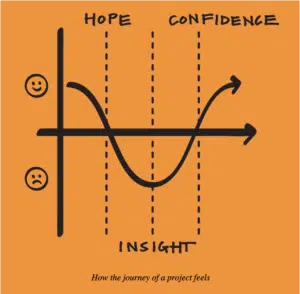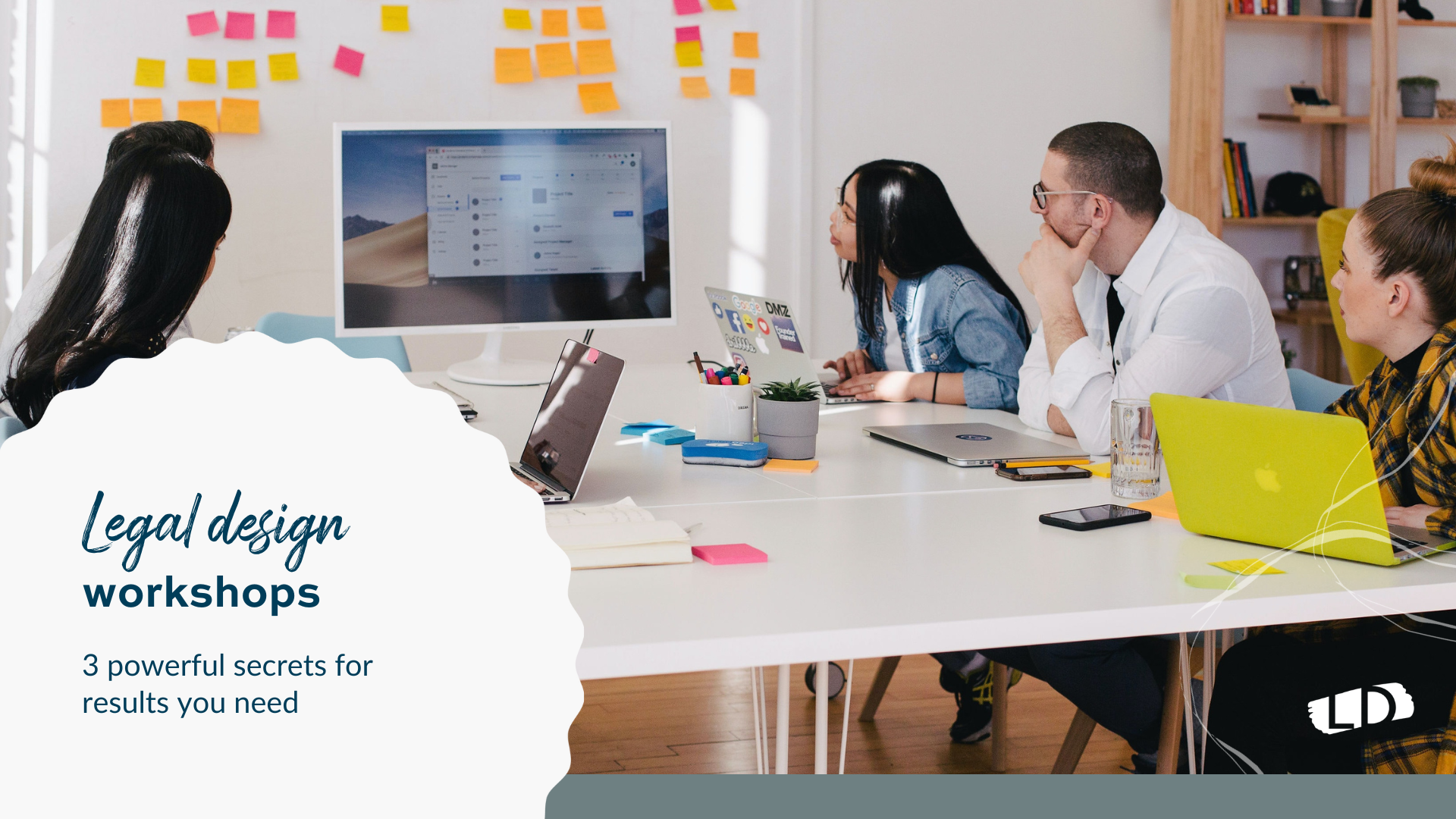The best way to learn legal design
The most effective way to learn legal design is in a workshop environment that incorporates three key ingredients.
- It’s live and interactive
- It’s experiential and practical
- Its social and reflective
Why? Because engaging the senses and working on real-life scenarios from your law firm ensures your learning is real, lasting and relevant for you. We know the learning sticks because we see it every day.
H2: Other legal design course options
You can try online, self-paced courses using a video format but the downside is that they’re passive (and statistics show only 15% of us finish online courses). Usually, we don’t finish the courses we start because we’re alone in our learning journey. Without a team to interact with and spur us along we aren’t accountable, fail to finish and don’t learn the skills we want to.
It’s almost impossible to learn legal design alone. By definition, it requires collaboration, teamwork and activity.
The secrets behind legal design workshops that get results
Here’s a sneak peek into our legal design workshops and the key ingredients for legal design training that works. If you want to learn new skills, put them into practice and make real change in your firm, here’s what to look for.
Live action
If you want results and real change, make the legal design workshop a live, real-time event.
Here’s why.
Concentrating is tough
Our concentration span is shorter than ever, we are not able to concentrate on any content for a very long time no matter how meaningful or interesting the content is.
Think about the last time you tried to read or listen to something from start to finish. If you managed to get through the first 15 minutes, pat yourself on the back.
Studies show that our attention is distracted every 15-20 minutes, but increasing screen time and heavily digitized lives reduce the time even more.
It’s no wonder we can’t get through yet another self-study course. We need active engagement, accountability, and someone to facilitate us through the learning experience in real time.
Change is challenging
Change is hard and doing it solo is even harder.
This applies to design projects as well as learning new skills. Anyone who’s been involved in design work probably knows that there’s an emotional swing that’s part of the process.
This image is from IDEO and it illustrates the emotional journey of a design process, how it varies from hope to despair and then back to confidence.

We deal with this emotional journey in real-time in the workshops. We help lawyers work through the discomfort because we like to quit when things get uncomfortable. In a self-paced environment, managing the discomfort that comes with change is difficult and people are more likely to quit at this point. We help people as it happens.
When you’re teaching something new and encouraging people to go beyond their everyday work and discover new things it can feel really scary. This challenge is best tackled in a live setting.
In our live workshops, we establish a safe space for learning. It’s the first thing we do because without the safe space we don’t have a solid ground to build on. People are scared, excited, insecure, happy, bored, tired, weary, skeptical and excited. It’s all normal and we encourage all the emotions.
We get so much positive feedback about our safe space after the workshops. There’s always at least one participant thanking us for talking about the safe space and inviting everyone to create that together.
Safe space allows tired parents, insecure juniors, support staff, and weary partners to come to the workshop just the way they are and have an equal voice in the training.
Let intuition, imagination and creativity flow in that space.
Make it experiential
Another secret to impactful legal design workshops is to make them experiential. It’s all about learning by hands-on doing.
Remember the days when you went to school? Teachers in front of students, distant and superior. Armed with facts and knowledge they wanted you to learn, the teacher taught and you listened, right? The teacher was the expert while students listened passively, trying to memorize the facts. Remember the monologues? Maybe sleeping with your eyes open?
This is a traditional approach to learning. An idea where the teacher is pouring information into your head. Many lawyers still hold on to this approach when they talk to an audience and give presentations.
“Legal design is a craft and you learn it the same as any other craft – by getting your hands dirty. Applying legal design is not an armchair exercise and it doesn’t happen by reading a book.”
The learning is and should be experiential, you learn by doing. Trying once and trying again until it’s right.
This is because we learn through active participation and active problem-solving. We need to bridge the gap between theory and practice by applying the knowledge and new skills simultaneously into practice. This also accelerates the learning process and ultimately the change we are seeking.
What’s more, the content in the workshop needs to be relevant and highly practical for the lawyers.
Lawyers have the patience of a 3-year-old, they need to be able to see the value of the workshop as well as the direct impact on their everyday work and business.
Lawyers, however, like other grown-ups, learn in completely different ways than children do. Children have elastic brains and they can learn and remember almost anything. For us grown-ups, the approach needs to be highly personalized and tied to everyday reality.
In our workshops at Lawyers Design School, we work on the real challenges, questions and problems the participants face in their firms. If we use imaginary cases it’s difficult to apply the learnings. Besides, there’s no better place to start than your own business, right?
When lawyers work on their own problems in the workshop, they are engaged and committed and highly motivated to work through the process.
Make it social and reflective
The third secret to effective legal design workshops is to make them social and reflective.
Learning is a social phenomenon and legal design workshops are fundamentally social events. We do not learn from listening to the teacher, we learn from interacting with each other.
Sharing and reflecting with others inside a workshop is as powerful as you can get.
When we interact with each other we build a new understanding together, we remember and apply. Even if you’re a high-calibre expert in one area, you might be a complete novice in another. You can learn much more by interacting with people with complementary yet different expertise.
If there’s no one you can share your thoughts with after your ‘a-ha’ moment or bounce ideas to get feedback, new thoughts don’t stick. But when you get a chance to build your ideas on top of each other, you get further, it’s meaningful and you are committed to seeing it through.
Reflection means the way we critically evaluate our knowledge, skills and performance during a workshop. It means taking time to look back at the workshop and think about what we have learned and what we are taking to our work.
For legal design workshops, reflection is the cherry on the cake. It’s the practice that summarizes the hard work and puts the new insight into perspective. I like to think of it as a shortlist of the workshop outcomes.
In our legal design workshops at Lawyers Design School, I always reserve some time for reflection at the end. I use various quick questions and discussion prompts to make people think about what they just experienced and what they can learn from it.
The key is to be deliberate and consistent with this practice and to make time and space for it before the workshop ends. Lawyers leave the workshop happy and content with their accomplishments and eager to put their new skills into practice.
Use the workshop secrets with your clients
These secrets aren’t just for learning legal design, you can use them in your work. Try this the next time you have a meeting with a client.
Create a safe space for the meeting
- Make the meeting and the environment easy and safe. You can do this by, say, reassuring the client they don’t need to know everything and you’ll explain everything when you meet.
- Think about how you can neutralize power differences so that the client feels they’re equal. How can you show up as a person?
- Ask open questions and listen to your client.
Collaborate with your client in various ways
- Prepare materials and questions you can work through together. Enable your client to take an active role in the discussion and share their thoughts and ideas so it’s not just you talking.
- Try a visual exercise together with sticky notes while you talk through the different points of the case. In a previous episode, I talked about visual law, if you missed it go check that out.
Reflect together
- Always leave room for reflection at the end of each session.
- Ask what went well? What did you learn? What could have been done differently?
Now it’s your turn. What did you discover today? (You see, this is ‘reflection’ in action.)
Could learning legal design in a safe place be the ticket you need to give it a try? Take a look at the range of legal design workshops and see if one is suitable for your situation.
Coffee with Hannele Korhonen: Happy customers and happy lawyers. Episode 12.
You’ve just read a summary of my Instagram Live session. I run them weekly for law firm owners who are looking for actionable advice and tips on how to get more happy clients and make themselves happy lawyers with the help of legal design thinking.
If you’ve read something that interests you, I’d be delighted to see you at the next session.
Want to chat about it?
Did you start thinking about what a legal design workshop might feel like for you and whether it could help with your legal work?
I’d love to hear your thoughts so please feel free to DM me.
If you’ve got a question, join me on Instagram every Wednesday at 8 am ET where you can ask me about the client experience in your firm.
You can find me at @lawyersdesignschool and get more practical tips on building a thriving law firm, how to find new clients and become a happy boutique law firm owner.
Prefer email? Drop me an email at [email protected]. And while you’re here, take a peek at the Lawyers Design School and check out other ways to use customer-centric thinking to grow your law firm and thrive in your business.
Watch all the Happy customer and happy lawyers episodes.
Grab a virtual coffee with me and let’s figure out the next step!


